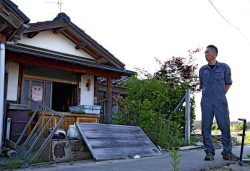Asthma, Bronchitis Patient Increase in Northern Noto Peninsula Likely Caused by Dust from Cleaning Rubble

A residential area, covered with piles of rubble and driftwood from heavy rains, is seen in Wajima, Ishikawa Prefecture, on Sept. 22.
15:13 JST, December 21, 2024
KANAZAWA — The number of asthma and bronchitis patients has increased sharply in the northern Noto Peninsula area of Ishikawa Prefecture, which was severely damaged by the Noto Peninsula Earthquake in January and heavy rainfall in September.
Compared to pre-earthquake levels, the number of patients in some areas has increased 1.5 to 2.5 times, so medical experts are calling for caution, believing dust and dirt raised while rubble was being cleared may have contributed to the increase.
Taiichi Kirimoto, a 62-year-old representative of Wajima Kirimoto, which manufactures and sells wooden products and lacquerware in Wajima, was diagnosed with a relapse of asthma in mid-September.
After the earthquake on Jan. 1, he worked to clean up his workshop, and he has also been attending events across Japan since April in the hope of helping Wajima’s recovery. After that, his breathing became shallow, he had a feeling that he was not getting enough oxygen and he was experiencing feverishness, but he did not rest, saying, “This is not the time to go to the hospital.”
However, on the recommendation of a family member, he went to see a doctor who explained that his symptoms had worsened due to stress and fatigue caused by the earthquake.
“All I can do is wear a mask and be careful,” Kirimoto said.
At Anamizu General Hospital in the area, 144 patients were diagnosed with asthma from January to August, 1.7 times more than in the same period of the previous year. Acute bronchitis increased 2.5 times to 159 patients, and acute pneumonia increased 1.5 times to 194 patients.
Another hospital also saw a sharp increase in the number of patients with respiratory illnesses, and in some cases, patients whose conditional had deteriorated were transferred to a hospital in Kanazawa.
According to Takeshi Ishizaki, director of the northern Noto respiratory disease center at Anamizu General Hospital, who is in charge of medical examinations, one of the causes is believed to be the inhalation of rat feces and dust from construction materials. The fact that the victims had removed their masks during the summer, when microorganisms and bacteria are more active, is also believed to have contributed to the increase.
“Many people prioritize rebuilding their lives and do not see a doctor until their condition worsens,” said Ishizaki, who himself lives in temporary housing. “Even a cough or sore throat that lasts only a few days may indicate a respiratory disease.”
He urges people to take basic precautions such as wearing a mask, drinking plenty of water and breathing through the nose.
"Society" POPULAR ARTICLE
-

M4.9 Earthquake Hits Tokyo, Neighboring Prefectures
-

M7.5 Earthquake Hits Northern Japan; Tsunami Waves Observed in Hokkaido, Aomori and Iwate Prefectures
-

Tsukiji Market Urges Tourists to Avoid Visiting in Year-End
-

Israeli Tourists Refused Accommodation at Hotel in Japan’s Nagano Pref., Prompting Protest by Israeli Embassy and Probe by Prefecture
-

M5.7 Earthquake Hits Japan’s Kumamoto Pref., Measuring Upper 5 Intensity, No Tsunami Expected
JN ACCESS RANKING
-

Keidanren Chairman Yoshinobu Tsutsui Visits Kashiwazaki-Kariwa Nuclear Power Plant; Inspects New Emergency Safety System
-

Imports of Rare Earths from China Facing Delays, May Be Caused by Deterioration of Japan-China Relations
-

University of Tokyo Professor Discusses Japanese Economic Security in Interview Ahead of Forum
-

Japan Pulls out of Vietnam Nuclear Project, Complicating Hanoi’s Power Plans
-

Govt Aims to Expand NISA Program Lineup, Abolish Age Restriction
























